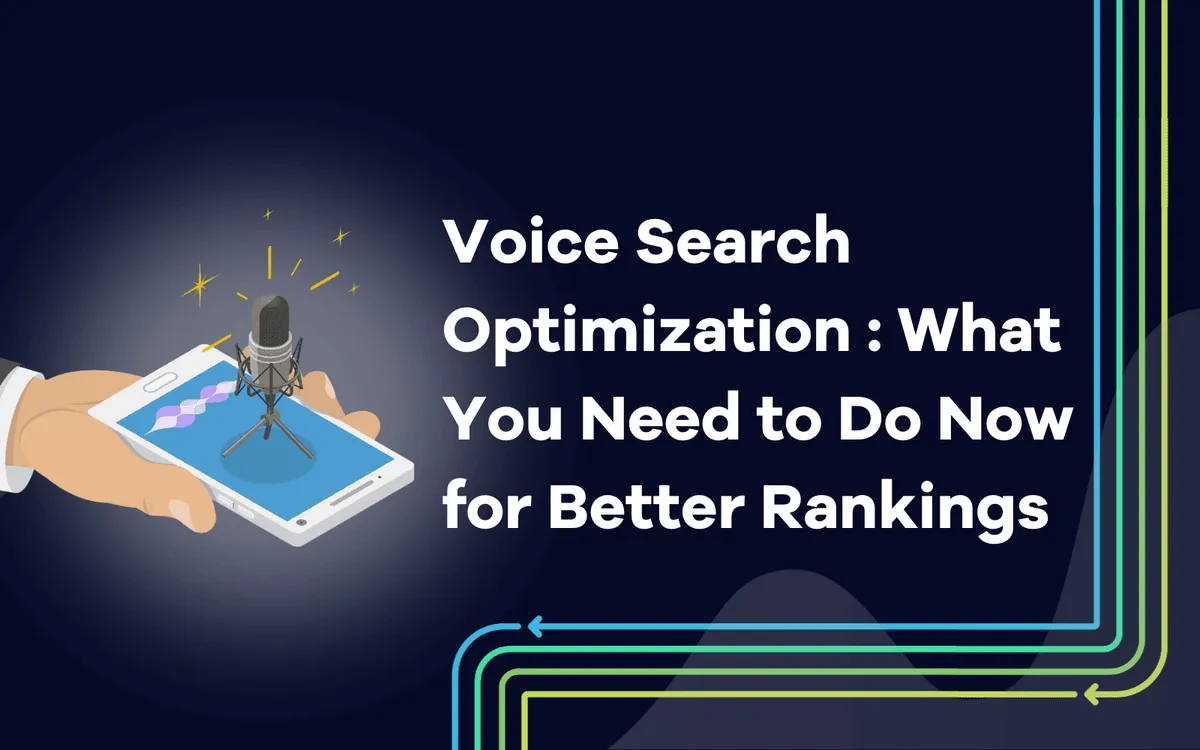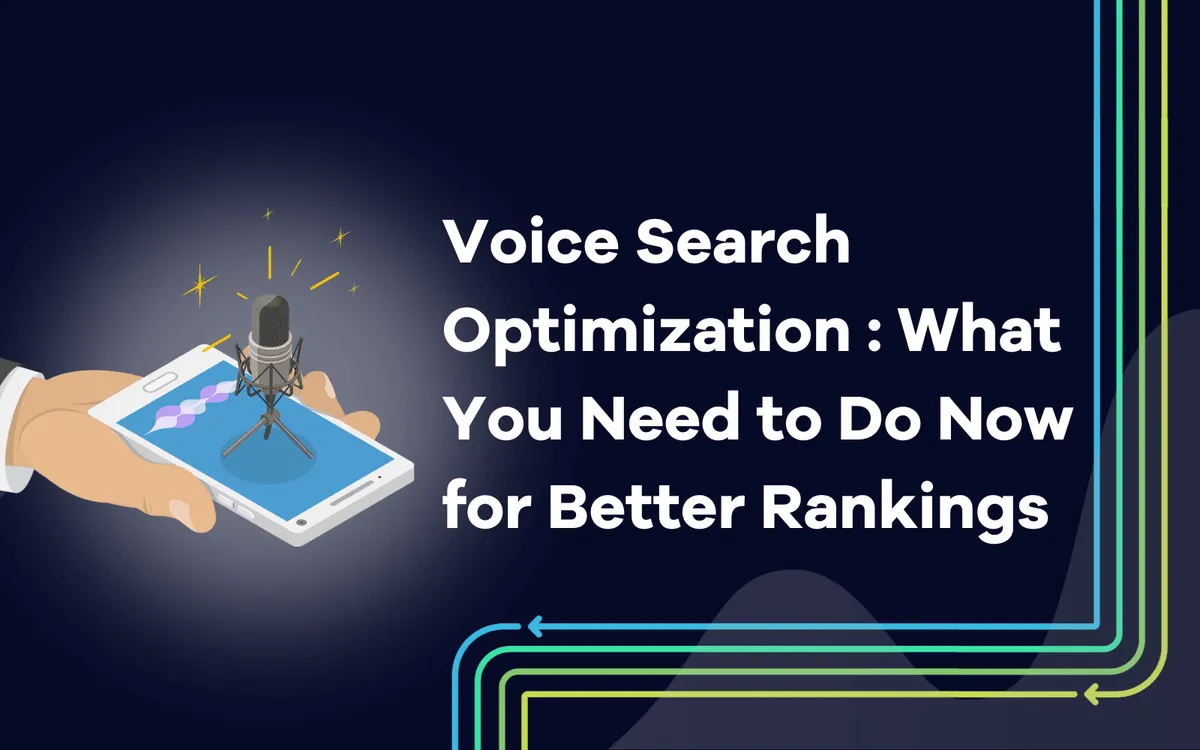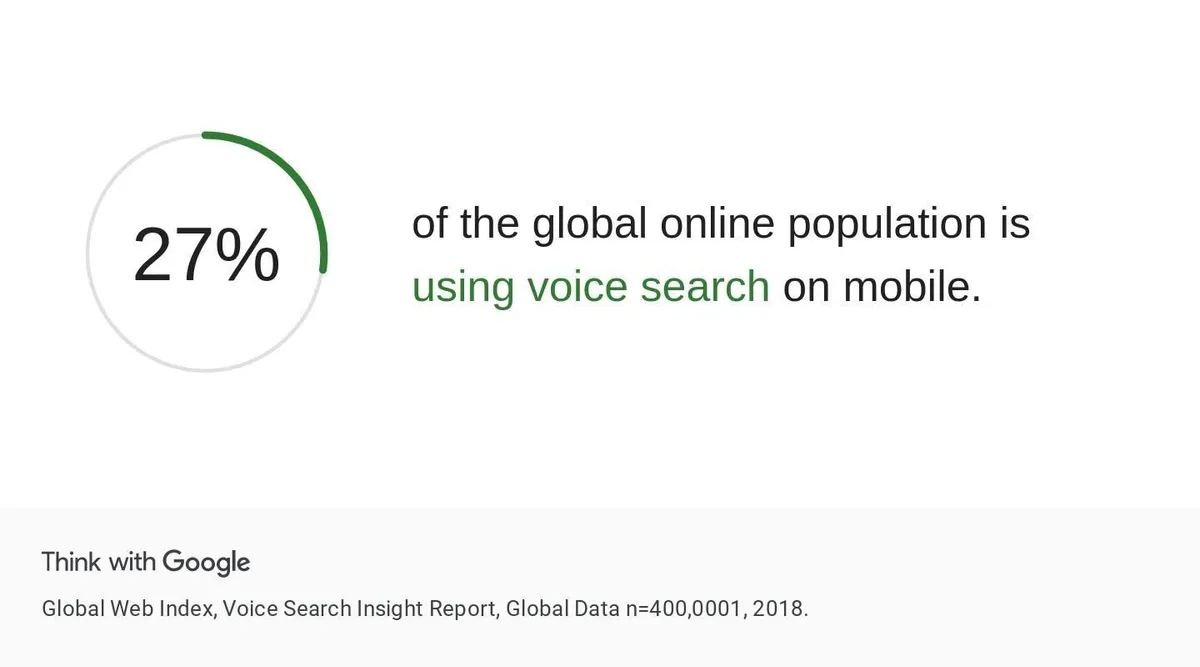
Voice Search Optimization: What You Need to Do Now for Better Rankings

Kachi Eloka
November 17, 2023
Unlock the secrets of Voice Search Optimization with our comprehensive guide. Learn essential strategies to boost your website's rankings and stay ahead in the ever-evolving landscape of digital search.

Over the years, voice search has been said to be the future of online searches. And while the rise of this trend might not have occurred as quickly as earlier predicted, it still can't be overlooked. That is because voice assistants are now everywhere.
We see them daily, from Google Assistant or Siri on mobile phones to Alexa on smart home devices. These digital assistants rake in over one billion voice searches monthly, with this number projected to increase.
With these trends in mind, it's necessary to place some importance on voice search optimization (VSO), just as you optimize for text.
How is voice SEO different from text SEO?
If you've been implementing SEO strategies for a while, you'd probably wonder, "What is the difference between voice search optimization and text SEO?" The answer to that question would be "a lot."
We'll start by reassuring you that you won't need to overhaul all you know about SEO or abandon your existing strategy. You'll still have to rank for keywords but the phrases differ here.
For instance, if you're craving Chinese food, you'll probably type "Chinese restaurants near me" into a search engine. However, if it were a voice assistant, you'd be more likely to say something like this. "Which Chinese restaurant is closest to me?"
By default, we talk to voice assistants like real people and for this reason, voice search queries are usually longer and more conversational. They also contain long-tail keywords frequently overlooked for shorter ones with more search volume.
If you think voice search optimization would be easier thanks to the low search volumes of long-tail keywords, think again.
Digital assistants usually list only the first search result for their queries. That means your voice SEO and content should be top-shelf quality to occupy those lauded spots. We'll show you how to achieve that.
How does voice search work in SEO?
Voice searches are nearly instantaneous in their delivery of results. However, a lot goes on behind the scenes to turn verbal inquiries into queries on a search engine. The mechanics involved are complex, but having a basic understanding of how it works would aid in your voice search optimization.
Voice searches operate through Automatic Speech Recognition (ASR) software. These systems are designed to separate your voice commands from all the ambient noise, convert them into text, and feed them into search engines as queries.
Here is the sequence of activities that occur when a search is made through a voice assistant.
- Voice filtration and enhancement: When the voice command is given, the ASR software identifies and enhances the sound, removing the background noise to improve clarity.
- Conversion to digital data: Next, the software converts these sound waves to digital data, which can now be processed.
- Voice analysis: The processing begins. The data is split into smaller parts for in-depth analysis of the sound patterns.
- Translation: The ASR software begins recognizing individual words and arranges them into meaningful sentences that search engines can understand.
- Connection to the search engine: The ASR then connects to the search engine. It feeds the translated voice query into it and waits for a response.
- Output of results: Once the results are ready, they are returned to the user. They could be displayed on the screen or read back to the user in the case of smart speakers.
What are the benefits of voice search optimization?

Source: Think With Google
Standard SEO lets your business reach a wider audience, enhancing visibility and traffic. With Voice Search Optimization, you gain an additional demographic of users: the voice searchers.
This demographic accounts for 27% of searches on the Google app. With 8.5 billion searches being processed on the engine daily, this is a massive part of the market you shouldn't overlook.
Here are a few ways you can benefit from tailoring your SEO a bit more to voice searches:
Increased visibility. By 2024, there will be 8.4 billion active voice assistant devices worldwide. That’s a 2× increase from the numbers in 2023. With voice search optimization, you position your business to be seen by that number of customers.
- Increased traffic: Voice assistants show a minimal number of results. These results can direct the searcher to your website, increasing traffic.
- Enhanced user experience: Many voice search optimization changes involve improving technical SEO. That leads to a better user experience for your website.
- Higher conversion rate: Many users make voice searches to enquire about products they wish to buy. A search for "Chinese restaurants near me" is usually done when you're ready to patronize an establishment that caters to that need. Ranking in that voice search means your business would be expecting a customer.
- Local traffic boost: Most voice searchers scour the internet for local listings, having their assistants point them to the nearest store offering a specific service. With your website appearing in the search results, you'll enhance your local patronage immensely.
While your SEO strategy may have been doing well for years, these are some perks you've missed without VSO. As you can see, they're quite substantial.
Voice searches have become so important that neglecting them would harm your business. However, you'll need to make a few changes in your SEO strategy to leverage these assistants for enhanced visibility. We'll walk you through those soon enough.
Voice SEO best practices: 7 techniques to maximize success.
The benefits of voice search optimization for your business may be exciting, but you can't achieve them without making changes. Here are a few of the best practices you can replicate in your business for the best results.
#1. Target questions and long-tail keywords
The first step in Voice SEO is to target long tail and question keywords in your content. These phrases usually have two to three words and a lower search volume. However, they yield high-intent traffic due to how specific they are to the user's needs.
You can insert some locational modifiers to the keywords to make them more specific to your business. For instance, "Chinese restaurant in Boston" instead of "Chinese restaurant." That would reduce competition on the results page and increase your local SEO.
Most voice searches are questions, so you can anticipate during your keyword research and answer them in your content. Think of some inquiries that users are interested in, place them in an H2, and give a short answer afterward.
Ensure it’s less than 29 words, as that's the average length of voice assistant replies. You can go into detail after the answer if more clarification is necessary, and you can even use AI tools to help you find the right keywords.
#2. Use conversational language
It's always best to write content in a conversational style. Not only does it make your words easier to read, but it also ensures your reader understands your message. Finally, voice searches regard this content style as more relevant. Here's how to do it.
- Leave out the technical language: You may understand them perfectly as an expert in your field, but those industry-specific terms are gibberish to the layman. Try to explain your concepts in simple words. Consider using a writing assistant to speed up this process.
- Use the second person: Using the second person in your writing makes it sound more like a conversation and less like a lecture. It makes it more personal, and voice assistants love that.
- Use short sentences and contractions: We use contractions in conversations. Instead of "I am an SEO expert," you say "I'm an SEO expert." Do this in your writing as well. Try to keep your sentences short, as long sentences reduce your readability.
These are a few SEO tools we recommend to help you write better.
#3. Insert an FAQ page
Trying to fit questions and answers into your content can be tricky sometimes. However, a Frequently Asked Questions (FAQ) page or section can fix that. You can list some common questions related to your business and supply clear solutions to vie for the top spot.
An FAQ page can help get you into Google's featured snippets. That’s position #0, which sits above the SERP's first result. Getting to that spot can also help your VSO, as 40.7% of voice searches come from featured snippets.
#4. Use schema markup
Schema markup—or structured data—is a language search engines use to understand the content published on your website’s pages. It provides specific information about your business. That includes everything from contact information to pricing.
Your human visitors don't see your markup, but the indexing bots do. They then display this information in your search results, attracting more clicks to your website.
This increase in visibility doesn't just apply to text searches but to voice queries as well. Schema markup makes your site seem more relevant, and that's always good.
#5. Optimize for mobile users
Mobile users account for more than half of global website traffic. Not only that, but mobile optimization is also a factor Google considers for its rankings.
For these reasons, many sites embrace trends that elevate mobile user experience. Here are a few of them:
- Responsive design: This design ensures that your website adapts to your user's device. UI elements, text, and images are all tweaked to display correctly on any screen size.
- Scannable text:. Few mobile users read all the content on your page. Instead, they scan through to essential points and avoid websites that aren't scannable. So, break up your texts into subheadings and bullets to help them out.
- Optimize visual content: Images and videos significantly boost mobile user experience. However, they may also affect your page speed. You can reduce their file sizes and use alt texts to optimize them. As a tip, you can create a video for free that will correspond to all the standards of your website.
#6. Keep your site fast
Page speed is an essential factor affecting SEO in text and voice searches, but it is a lot more critical for the latter.
Voice search results load blindingly fast. We're talking nearly 4× the speed of the average webpage. And it's all about the user experience. No one wants to wait too long for an answer from their voice assistant. The assistant, in turn, won't wait for your site.
So, analyze your page speed with your preferred tool and find ways to optimize it. The rule of thumb is to load your pages in less than two seconds. Anything over that is too slow.
#7. Focus on local SEO
Local SEO is a huge part of voice search optimization for brick-and-mortar businesses. It targets consumers within your store's geographical radius, and voice search leans into this. Your site won't appear in a "nearby" search if Google isn't aware you're based nearby.
The easiest way to do this is by creating and updating your Google Business Profile. This tells users your location, contact info, and other important information about your business. These pop up in voice searches, improving your visibility.
Do you need to optimize your website for voice search?
Yes, you do need to optimize your website for voice search. We'll tell you why:
- The market is huge: The global voice assistant usage trends show that the numbers will keep increasing. By 2024, voice search optimization will give your business access to 8.4 billion devices. That is bigger than the world's population.
- Google seems to be going voice first: From some announcements from Google, we can glean that they're giving more priority to voice search. Soon, webpages that aren't voice-search-optimized would find ranking more difficult. You don't want this to be your business.
- Hit two birds: VSO practices aren't much different from standard SEO. Some of these practices are probably already included in your SEO strategy, so it makes sense.
Conclusion
As a business owner in 2023, voice search optimization should be prioritized. It increases your visibility, boosts traffic, and places your business in a favorable position for growth.
However, it is also a continuous process that requires regular tweaks. An SEO tracker tool like Accuranker would be invaluable to monitor your efforts and determine what works.
So, apply these best practices in your business and track your progress. You'll be seeing an uptick in your metrics soon enough—you only have to start today.
Related blog posts

AI Overviews Are Taking Over SERPs
From traffic drops to decreasing CTRs, AI Overviews are shaking up SEO. Learn what is happening and how AccuRanker helps you track AIO.
25 June 2025
How AccuRanker’s AI Models Fix Inaccurate SEO Data
Struggling with unreliable SEO data? Discover how AccuRanker’s CTR, Search Intent, Search Volume, and Share of Voice deliver accurate insights.
1 June 2025
Why Your CTR Model Is Betraying You
The static CTR model relies on outdated averages. Learn more about how AccuRanker's dynamic CTR model helps you prioritize your SEO efforts.
13 May 2025



